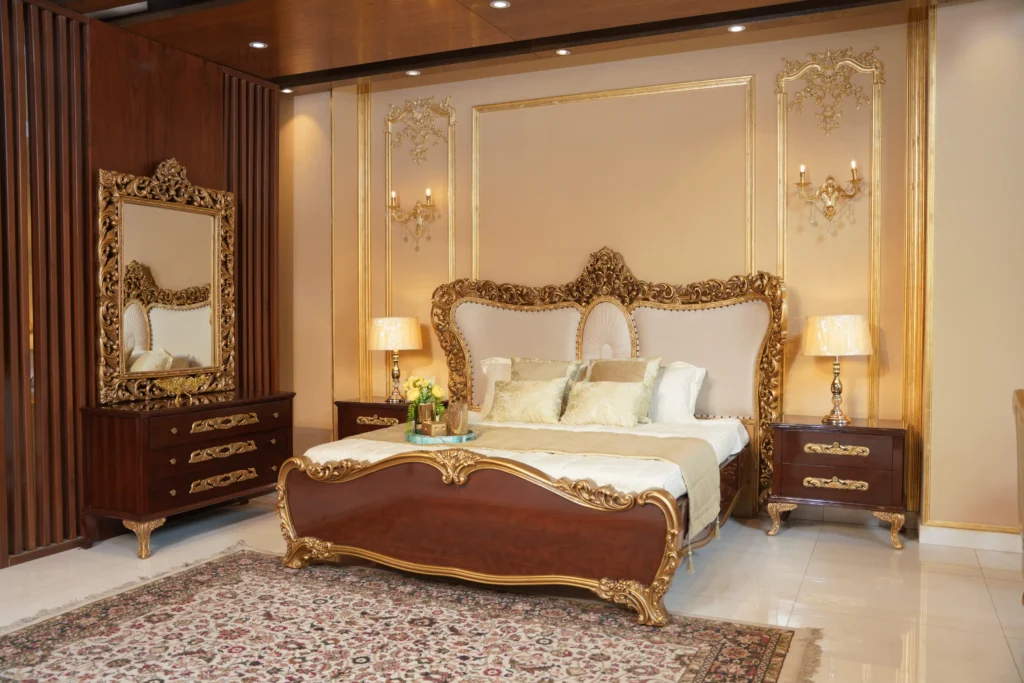Why Is My Bed Making Noise and How to Fix It?
A noisy bed can be one of the most annoying things to deal with at home. You turn over to get comfortable, and suddenly creak. That sound can ruin your sleep and peace of mind. Whether you have a wooden Chinioti bed, a metal frame, or a modern upholstered design, bed noise is a common issue in Pakistani homes.
In this guide by Classy Chiniot Furniture, we’ll help you understand why your bed is making noise and how you can fix it with easy, practical solutions. Let’s bring back the quiet comfort to your bedroom.

Understanding Why Your Bed Is Making Noise
The first step in fixing a noisy bed is understanding where the sound comes from. Most creaks and squeaks come from loose joints, old fittings, or weak bed slats. Over time, daily use, humidity, and movement can cause the joints or screws to loosen.
In Pakistan’s weather—especially in humid areas—wood expands and contracts, making traditional wooden Chinioti bed frames more likely to creak if not maintained properly. Recognizing the type of noise helps identify whether it’s coming from the frame, mattress, or floor.
Common Causes of Bed Noise
A squeaky bed isn’t always because it’s old—it’s usually because of a few common mechanical or structural issues. Let’s look at what might be causing the problem in your bed.
Loose Joints or Screws: Over time, screws and bolts can become loose from movement or weight.
Wood Expansion: In cities like Lahore or Karachi, humidity can cause wood to swell, making wooden joints rub and creak.
Weak Bed Slats: Cheap or thin slats bend easily, creating sound when you shift weight.
Metal Friction: Metal beds or hybrid designs squeak when metal parts rub together.
Old Mattress or Box Spring: Sometimes the noise isn’t the bed—it’s the mattress coils or foundation underneath.
If you can identify which part of your bed is responsible, fixing it becomes much easier.
How to Find the Source of the Noise
Before trying to fix anything, find out exactly where the noise is coming from. It might seem small, but it saves you time and effort.
Start by applying gentle pressure to different parts of your bed—headboard, frame, slats, and mattress—one at a time. Ask someone to listen closely as you press down on each area. When you hear the creak, mark that spot.
In Pakistani homes, where many beds are made of solid Sheesham or rosewood, the sound often comes from the headboard or the side joints that connect to the legs.
Quick Fixes for a Noisy Wooden Bed Frame
If your bed is made from Chinioti wood or other hardwoods, a few simple fixes can make a big difference.
Tighten All Screws and Bolts: Use a wrench or screwdriver to secure all joints.
Add Rubber Washers: These act as a cushion between metal bolts and wood, reducing friction.
Apply Wax or Soap: Rub a little candle wax or soap where wooden parts meet—this helps them slide quietly.
Use Wood Glue for Loose Joints: A small amount of strong wood glue can stop wooden components from rubbing.
These solutions are especially helpful for hand-carved wooden beds in Pakistan, where even minor movement between joints can cause creaks.
How to Fix Noise in a Metal Bed Frame
Metal beds are popular in Pakistani apartments because they’re lightweight and easy to move—but they can squeak due to friction and loose bolts.
Start by tightening all metal connections. If the noise persists, apply a lubricant like WD-40 or even coconut oil to the joints. It reduces metal-to-metal contact.
Also, place rubber pads or felt strips between metal connections. This not only reduces sound but also protects the paint coating from damage.

Fixing a Noisy Headboard
Your headboard might look elegant, but it can also be the main cause of squeaking. In traditional Chinioti bed sets, the headboard is often large and intricately carved—making it prone to slight movement.
Make sure your headboard is firmly attached to the bed frame or wall. If it’s wall-mounted, check the anchors and re-tighten them. You can also add foam or fabric padding behind the headboard to absorb vibrations.
Mattress Noise – Is It the Real Culprit?
Sometimes, the noise doesn’t come from the bed frame at all. If you have an old spring mattress, the metal coils inside might be making the sound.
To check, place the mattress on the floor and press different areas. If it squeaks, it’s time for a new mattress. Many Pakistani households use hybrid mattresses with inner coils—these often become noisy after 4–6 years of use.
Consider switching to memory foam or latex mattresses, which are silent and supportive.
How to Stop Your Bed from Moving or Shifting
Movement can also create unwanted noise. Beds placed on smooth tile or marble floors (common in Pakistan) tend to slide slightly, making a creaking sound.
You can fix this by:
Using non-slip rubber pads under each bed leg.
Placing a carpet or rug underneath the bed frame to reduce vibration.
These small adjustments not only stop noise but also protect your flooring from scratches.
Preventive Maintenance for Long-Term Silence
Preventing bed noise is easier than constantly fixing it. Just a few simple habits can help keep your bed quiet and strong for years.
Check Screws Monthly: Tighten any that feel loose.
Clean Bed Joints: Dust and dirt can worsen friction between wooden parts.
Avoid Overloading: Don’t exceed the recommended weight capacity.
Use Bed Leg Protectors: They reduce floor impact and prevent sliding.
If you have a Chinioti solid wood bed, a yearly polish or oiling helps maintain both shine and structural stability.
When to Replace Your Bed Frame
Sometimes, even the best fixes can’t stop the noise—especially if your bed is old or poorly built. If the frame is cracked, warped, or repeatedly loosens after tightening, it might be time to upgrade.
Investing in a high-quality Sheesham or Walnut wood bed can be a one-time solution that lasts decades. At Classy Chiniot Furniture, we design solid, handcrafted beds that combine beauty, durability, and silent stability—perfect for Pakistani homes.
Why Wooden Chinioti Beds Stay Silent Longer
Unlike mass-produced metal or MDF frames, Chinioti wooden beds are known for their sturdy joinery and solid structure. The craftsmanship ensures every joint fits tightly, reducing the chance of future squeaks.
Sheesham, teak, and walnut woods used in Chiniot are naturally dense and resistant to deformation. When properly maintained, these beds stay firm and noise-free for generations—making them an ideal choice for luxury bedrooms in Pakistan.

FAQs – Fixing Noisy Beds in Pakistan
If you’ve tightened everything and it still squeaks, the problem may be with friction between wooden parts or a loose headboard. Apply wax or padding between joints to reduce movement.
Yes, Pakistan’s humidity can cause wood to expand and contract, leading to creaks. Regular polishing and keeping your bed in a dry area can prevent this.
Try using household items like soap, candle wax, or rubber pads to cushion the joints. These simple tricks often work well for mild noise.
Check your bed frame every 2–3 months. Tighten bolts, clean joints, and polish the wood once a year to keep it in top condition.
A solid Sheesham or walnut wood bed crafted by Classy Chiniot Furniture is your best option for noise-free comfort and elegant design.
Final Thoughts
A noisy bed doesn’t always mean it’s time to replace it—it usually means it needs a little care. By tightening, lubricating, and properly maintaining your bed, you can easily restore peace to your room.
If you’re looking for a quiet, durable, and stylish bed frame in Pakistan, explore Classy Chiniot Furniture’s handcrafted wooden bed sets. Each piece reflects traditional Chinioti artistry designed for modern comfort—so you can sleep soundly without a single squeak.
